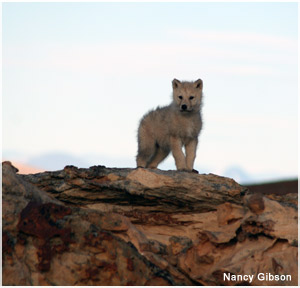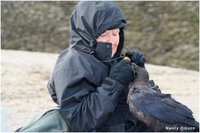 We return to the den and resume yesterday’s slow and careful efforts to accustom the wolves to our presence. As good luck would have it, all seven adults are in residence. They greet us and once again, they accompany us to the hilltop behind the den. We begin the process of trying to sort them out by looking for some identifying characteristics – a scar, a color pattern, a whorl of hair, an injury. The five yearlings are in full shedding mode.
We return to the den and resume yesterday’s slow and careful efforts to accustom the wolves to our presence. As good luck would have it, all seven adults are in residence. They greet us and once again, they accompany us to the hilltop behind the den. We begin the process of trying to sort them out by looking for some identifying characteristics – a scar, a color pattern, a whorl of hair, an injury. The five yearlings are in full shedding mode.  Ragged strips of fur and guard hairs hang from their shoulders, backs and flanks, waving in the wind like banners. One wolf wears a silver gray mantle across its shoulders and down its back. The others are white, and it will be our job to find some distinguishing marks so we can tell them apart.
Ragged strips of fur and guard hairs hang from their shoulders, backs and flanks, waving in the wind like banners. One wolf wears a silver gray mantle across its shoulders and down its back. The others are white, and it will be our job to find some distinguishing marks so we can tell them apart.
Late in the evening, 6 of the adults head out to hunt. A herd of musk oxen grazes placidly in the distance, and suspense builds as we watch the wolves split into two groups and stealthily approach these huge, shaggy beasts. The wolves ambush the herd, exploding from their hiding places like bullets, but the musk oxen react instantly by rushing together. Perhaps this herd is wary because they are used to being tested by the pack, and they are quick to form their defensive circle with the calves safely at the center. The wolves know their chances of catching an unguarded calf are next to zero. The jig is up, and they head off to the east. We find it remarkable that they can be miles away, yet we can still see them without the aid of binoculars. Like luminous dots on the sage green landscape, they trot tirelessly over the rough terrain, disappearing into gullies, popping up again as they traverse the higher ground.
No sign of the pups yet. We know they are hidden in the den, or they are simply out of sight behind the rocks at the front of the cave entrance. If there were no pups, the pack would not be together at this place. We take this as a signal that the adults are comfortable with us nearby, but they are not yet ready to bring the pups into view. We must be patient. We leave about 1:00 a.m.
 go on for the wolf pack – the pups and Mother and Brutus, Grayback and Dirt Ball, Redneck and Bottle Brush and Gimpy. Leaving them is terribly hard, but it is good to know they are healthy and thriving. Maybe they will be here next summer when Dave returns to continue his study of the wolves of the High Arctic and to share his discoveries with the scientific community and the general public as well.
go on for the wolf pack – the pups and Mother and Brutus, Grayback and Dirt Ball, Redneck and Bottle Brush and Gimpy. Leaving them is terribly hard, but it is good to know they are healthy and thriving. Maybe they will be here next summer when Dave returns to continue his study of the wolves of the High Arctic and to share his discoveries with the scientific community and the general public as well.


























